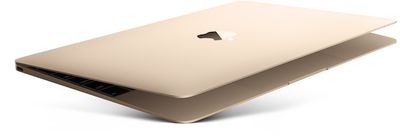In a comprehensive new Bloomberg article diving into the slow refresh cycle of Apple's line of Mac computers, and how the company slowly "alienated Mac loyalists," a few interesting tidbits surfaced providing insight into what could have been for the Touch Bar MacBook Pro, as well as the 12-inch Retina MacBook.
In the MacBook Pro line launched this past October, Apple planned to introduce "higher capacity battery packs" that would have been terraced and shaped to the inside compartment of the computer, boosting battery life in the process. According to a person familiar with the creation of the MacBook, the battery failed a "key test," so instead of delaying the laptop and missing the holiday shopping season, "Apple decided to revert to an older design." This created a domino effect that went on to hit other Mac design teams whose engineers were taken to finish the MacBook Pro.

In the run-up to the MacBook Pro's planned debut this year, the new battery failed a key test, according to a person familiar with the situation. Rather than delay the launch and risk missing the crucial holiday shopping season, Apple decided to revert to an older design.
The change required roping in engineers from other teams to finish the job, meaning work on other Macs languished, the person said. The new laptop didn't represent a game-changing leap in battery performance, and a software bug misrepresented hours of power remaining. Apple has since removed the meter from the top right-hand corner of the screen.
Battery life has been a big complaint among many MacBook Pro users, with some claiming in early December to get as little as 3 to 6 hours of battery life on a single charge. Some users claimed to see better battery life after updating to macOS 10.12.2 last week, but Apple "repeatedly and emphatically" told Ars Technica there are no specific battery life improvements included in the update. The laptop's battery "appeared to be performing as intended," according to the company.
The MacBook Pro is rated for up to 10 hours of battery life for the 13-inch and 15-inch laptop, but the Bloomberg article didn't specify how much that may have been increased by if the larger battery would have made it into the MacBook Pro.
The article continued by saying that a few early prototypes of last year's 12-inch Retina MacBook were built with ports for the iPhone's Lightning cable, but the MacBook eventually launched with USB-C instead. A gold colorway for this year's MacBook Pro was even planned, but Apple designers eventually decided the color didn't work "on such a large product."
These test runs for iPhone-like features on the MacBook are "part of a broader shift toward making Macs more like iPhones." The critique rests on Apple's inability to see what its more creative and loyal users need desktop and laptop computers for, instead opting to bring features from its best-selling product -- the iPhone -- into the Mac line.
That's part of a broader shift toward making Macs more like iPhones. Apple prioritizes features, like thinness and minimal ports, that sell its iPhones and iPads, which generated about 75 percent of revenue this year. Those are contrary to professional needs, like maximum computing power. Early prototypes of the 12-inch MacBook used the iPhone's Lightning connector, although this was ditched for a more standard USB-C port. There was even a gold MacBook Pro planned, but this was shelved because the color didn’t look good on such a large product.
The rest of the Bloomberg article is an interesting read, pointing towards the lack of a "singular vision" in Apple's design and engineering departments that leads to product delays and underwhelming reveals. In the end, dozens of Mac hardware managers and engineers are said to have left for different teams, or left Apple entirely, in the past 18 months. "Some were looking for a less all-consuming work environment, while others felt the future of Mac hardware was unclear in a world of iPhones and iPads."






















